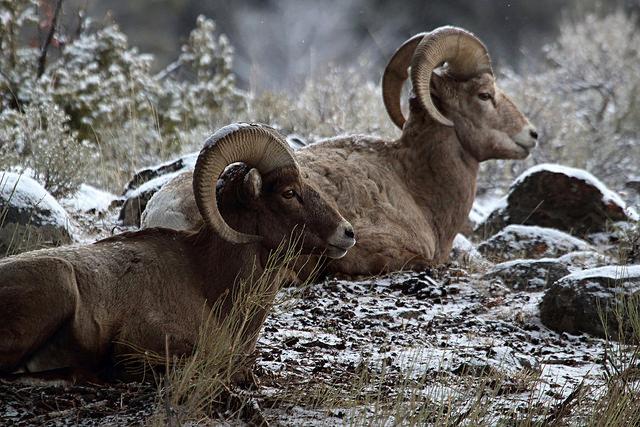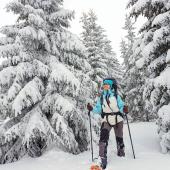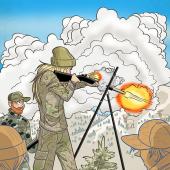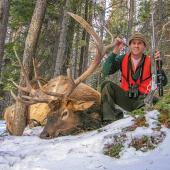Open Reason
Hunting for wild-sheep restoration.
In southwest Montana, where wildlife habitat is all around us, there are two chief methods for protecting wild creatures and wild places. One method is preservation—the non-use of something. Another is conservation—the sustainable use of that thing. The Wild Sheep Foundation (WSF), a Bozeman-based nonprofit, is a conservation organization dedicated to restoring wild-sheep populations in Montana and around the world. In early autumn, they hosted a harvest dinner, and served wild game in honor of the upcoming season. The WSF is also a hunting-oriented group, with most of its members being sheep hunters.
I'm not a hunter. When I received an invitation to the WSF's harvest dinner, it sparked in me a question I'd never given due consideration: how do people who shoot animals play such a prominent role in their protection? Here was an opportunity to learn. On the night of the dinner, I immersed myself in community, food, and discussion, the full import of which I did not yet understand. How does hunting fit in with wildlife conservation? Turns out, the two are tied securely at the hip.
The Organization
In 2008, Gray Thornton became president of the WSF. As the organization’s new leader, he moved the headquarters from Cody, Wyoming to Bozeman. “We did that for a number of reasons,” says Thornton. “To have access to Montana State University, to have access to a wonderful airport—we travel quite a bit—and to get into a younger demographic for employees.”
The implications of the move to Bozeman were apparent at the harvest dinner, down to the WSF’s college intern, the international guests, and a cast of young, enthusiastic staff members. Restoring sheep is a nuanced business, and many pieces must fall into place before even one animal is placed back in its habitat. Every infrastructural decision, such as moving the headquarters three hours north, matters. Wild sheep need help.

It costs about $4,700 to put one sheep on the mountain, factoring in transportation, net-gun trap, disease testing, and GPS collar. On an institutional level, sheep conservation is even more complex. It involves years of scientific research, policy advice, and public communication.
When it comes to scientific research of wild sheep, fighting disease is the number-one objective. Mycoplasma ovipneumoniae, mannheimia haemolytica, and a variety of other diseases commonly inflict domestic sheep in southwest Montana without killing them. But when these domestic sheep contact wild bighorn sheep, it’s often fatal. Or, bighorns that survive pass the disease onto other wild sheep. It’s like brucellosis among cattle and bison, but in reverse, and mass die-offs of bighorns have been recorded throughout the West. Like the brucellosis issue, sheep disease sparks confrontation between conservationists and owners of domestic animals. “We do not try to eliminate the domestic sheep industry, but we are advocates for bighorn and wild sheep,” says Thornton. “We work with the domestic sheep industry to hopefully keep the two species and cousins separated, but sometimes it can get nasty.”
The WSF also works with Congress to advocate for bighorn sheep on a legislative level, visiting Washington D.C. about twice a year, according to Thornton. Relative to elk, mule deer, pronghorn, and other wild game, says Thornton, there are fewer bighorn-sheep hunters—and therefore fewer people who place high value on them—to help garner funding for their conservation. So, keeping wild sheep in the legislative discussion has required long-term relations with the U.S. House of Representatives, U.S. Senate, Montana state government, Bureau of Land Management, and U.S. Forest Service.
Although the health and prosperity of wild sheep—like most issues concerning shared resources—is rife with disagreement, wild-sheep populations in North America are trending upward. Bighorn population estimates have grown from fewer than 25,000 in 1960 to more than 85,000 in 2012. Thornton, after working closely with all sorts of agencies and entities, attributes conservation success to cooperation and mutual respect. As the WSF approaches its third year in Bozeman, his optimism has only grown.
“There’s an interesting dynamic that I’ve seen since moving to Bozeman," says Thornton. “The conservationists and the preservationists for the most part can work together here. We talk not about the 10 or 20 percent that we disagree on. We talk about the 80 to 90 percent we agree on. We all want clean water. We want wild fish in the water. We love healthy forests. We love public land.”
And all these things are good not only for people, but for the sheep as well. They may still be susceptible to disease and nowhere near their population level prior to European settlement, but they do have an organization speaking on their behalf—and this organization lives in a community that has proven it can, for the most part, work together for the common good.
The Meal
Everyone huddled around high-top tables, clinking copper mugs and nibbling elk-sausage hors d’oeuvres. It was early autumn, and the WSF’s wild-harvest dinner was underway. The staff and their guests congregated in a refurbished white barn on the outskirts of Bozeman. A guitarist strummed soothing tunes in the background. WSF staff drove from across the country and flew from three continents for an evening in southwest Montana, to celebrate the cause that bonded them all.
Gray Thornton addressed guests one by one with a hand to the back. He wore a hunter-green blazer and a warm smile that indicated no one was leaving this party a stranger. Sure enough, before dinner I had met his wife Kelli, who conceived of this event, and I knew about his next hunting road-trip—to Florida, for wild boar. And after our conversation, he knew that I’d never been hunting. “Go introduce yourself to everybody,” he said. “We’re glad to have you.”
Emilio Rangel was there from Monterrey, Mexico, where he has reintroduced more than 500 desert bighorn sheep to their native range in Coahuila. So was Jack Evans, who guides hunts in Zambia. Wildlife biologists based in Texas and Oregon drove in for the occasion. And then there was Shane Mahoney. Head down, fingers stroking his white beard, he looked like an antique portrait of himself. Beneath his ashen mane, his face was stern, resembling that of a lion behind tall grass. Whereas Thornton mingled and shook hands, Mahoney kept to himself. I noticed him periodically slipping outside, presumably to review notes for the speech he would give later.

When dinner was served, everyone shuffled to the dining room, where hot bowls of venison chili waited. Fresh-baked bread and seasonal salad complimented vegetable hash and bison tenderloin. Heavy serving plates circled the table until everyone was satisfied, and then Thornton tapped a fork against his glass. He thanked everyone for coming, acknowledging each guest individually, before introducing his friend Shane Mahoney.
Not often does the quietest person in the room attract the most attention. At this party, Mahoney had done just that. When he finally stood in front of the table to deliver his speech, he had my complete, undivided attention.
The Man
Mahoney founded Conservation Visions, a Newfoundland-based global wildlife initiative, as a platform from which he works as a scientist, wildlife manager, policy innovator, strategic advisor, and conservationist. He first met Gray Thornton in the late 1990s in Houston, at a governor's symposium on hunting heritage. What developed from there was a lasting friendship and partnership for conservation work. Over the years, Mahoney has helped Thornton educate people on the North American conservation model; the two have spoken individually and tag-teamed talks at conservation events across the globe.
Standing tall behind a podium, gesticulating like a Baptist minister, Shane Mahoney preached conservation and stewardship to a captivated audience. He cataloged the fish, wild game, and fowl sustainably harvested in North America, examining them from a food-health, food-security, and organic-food standpoint.
With that data, he reminded the group—and showed me for the first time—how much hunters and anglers contribute to wildlife management. Acknowledging that hunters are a minority, he requested of the public not change, but awareness. Instead of pitting conservation against preservation, he encouraged conversation and understanding between hunters and non-hunters. Wild game—read: wildlife, full freezers, and dinner tables—are communal goods everyone loves. They fall into the 80 to 90 percent. Mahoney motioned to the crowd seated before him with a sweeping arm. “Wild harvests drive us to share,” he said.

After the speech, everyone clapped and Thornton shook Mahoney’s hand. The guitarist carried on. Waiters brought out apple pie with vanilla ice cream for dessert. I thanked the WSF for my meal—knowing from whom and where it came—and left.
The drive home was peaceful; the roads leading to the highway were dark and vacant. Mahoney's words, wild game meat, and camaraderie seeped slowly into memory as Bozeman's city lights grew brighter.
It’s difficult for some people to understand how someone who shoots animals can have a genuine interest in their protection. Before that night, I was one of them. I was neither conservationist nor preservationist, just confused. Although I had never taken a side, I still believed there was a side to choose. Mahoney, Thornton, and friends of the WSF from across the globe gathered at the harvest dinner proposed a simple message: the best way to save sheep is through cooperation. I’ve never shot an animal, and maybe I never will. But for the first time, I understand the role of those who stand behind the barrel of a rifle.











